MBA Dissertation: Employee Turnover in Singapore Food Manufacturing
VerifiedAdded on 2023/03/29
|90
|18546
|244
Thesis and Dissertation
AI Summary
This dissertation investigates the critical issue of employee turnover within Singapore's small and medium-sized enterprise (SME) food manufacturing sector, focusing on the younger generation. The research aims to determine the significance of salary packages and benefits as key factors influencing employee retention and turnover rates. The study encompasses a thorough literature review, exploring existing research on salary, benefits, and employee turnover, particularly within the context of the Singaporean food manufacturing industry. The methodology involves a quantitative approach, employing surveys to gather data from employees in the sector. The findings are analyzed using correlation and regression analysis to identify relationships between salary, benefits, and turnover rates. The dissertation includes demographic analysis, descriptive statistics, and inferential analysis to provide a comprehensive understanding of the factors influencing employee decisions. The research questions address the relationship between salary packages, benefits, and employee turnover. The dissertation concludes with recommendations for improving salary packages and benefits to positively impact employee retention and offers suggestions for future research directions within this vital sector. The study is significant in the sense that it analyzes the impact of a good salary package on the work efficiency of the employees.
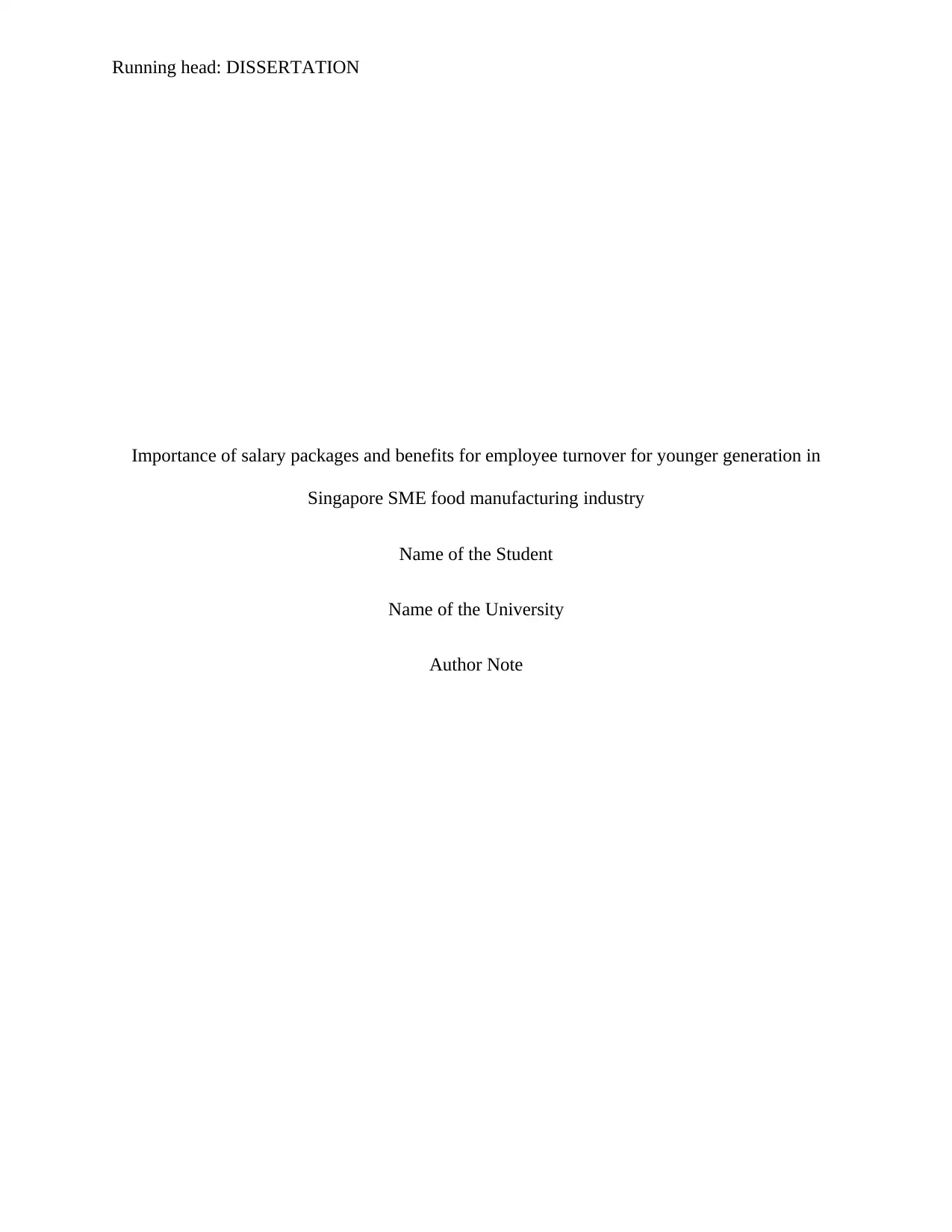
Running head: DISSERTATION
Importance of salary packages and benefits for employee turnover for younger generation in
Singapore SME food manufacturing industry
Name of the Student
Name of the University
Author Note
Importance of salary packages and benefits for employee turnover for younger generation in
Singapore SME food manufacturing industry
Name of the Student
Name of the University
Author Note
Paraphrase This Document
Need a fresh take? Get an instant paraphrase of this document with our AI Paraphraser
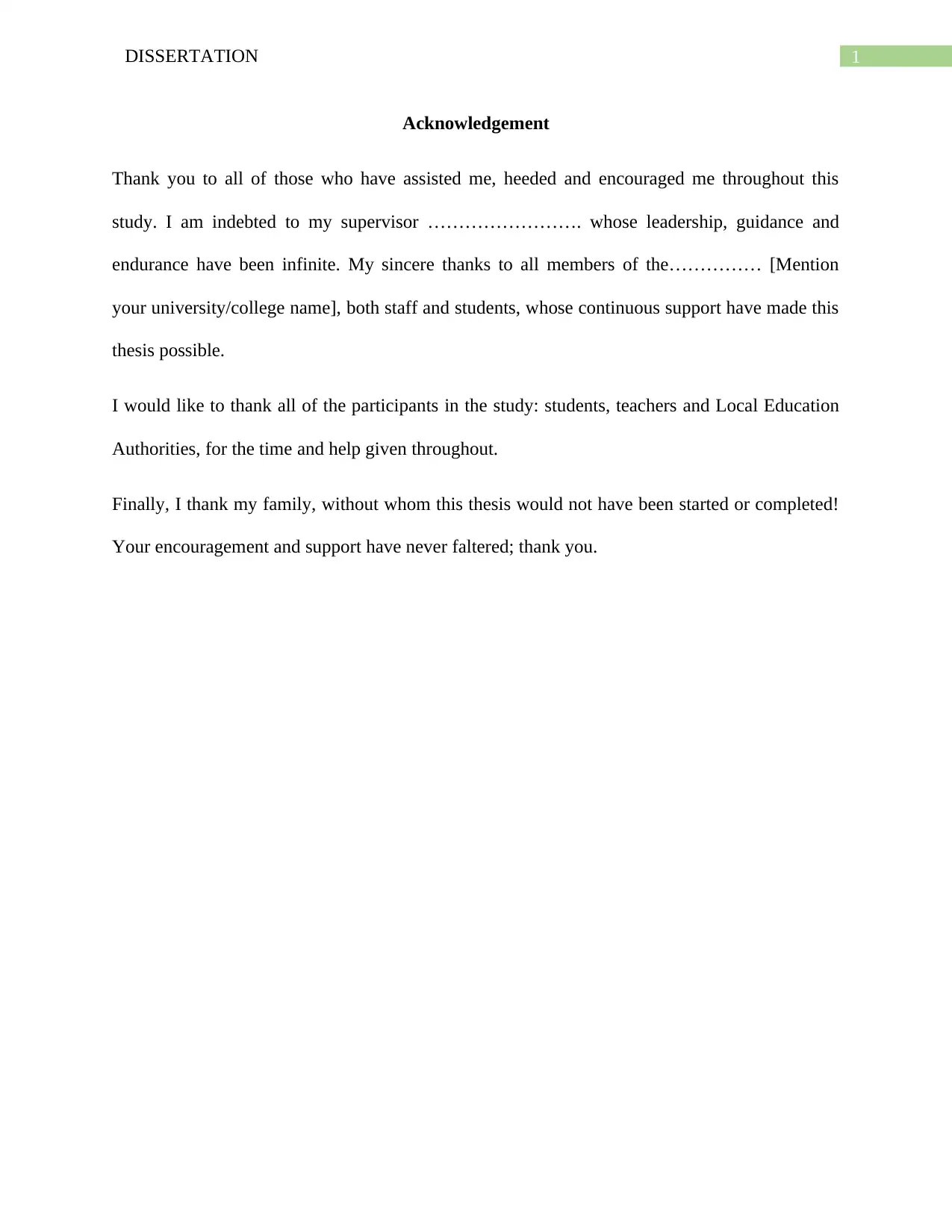
1DISSERTATION
Acknowledgement
Thank you to all of those who have assisted me, heeded and encouraged me throughout this
study. I am indebted to my supervisor ……………………. whose leadership, guidance and
endurance have been infinite. My sincere thanks to all members of the…………… [Mention
your university/college name], both staff and students, whose continuous support have made this
thesis possible.
I would like to thank all of the participants in the study: students, teachers and Local Education
Authorities, for the time and help given throughout.
Finally, I thank my family, without whom this thesis would not have been started or completed!
Your encouragement and support have never faltered; thank you.
Acknowledgement
Thank you to all of those who have assisted me, heeded and encouraged me throughout this
study. I am indebted to my supervisor ……………………. whose leadership, guidance and
endurance have been infinite. My sincere thanks to all members of the…………… [Mention
your university/college name], both staff and students, whose continuous support have made this
thesis possible.
I would like to thank all of the participants in the study: students, teachers and Local Education
Authorities, for the time and help given throughout.
Finally, I thank my family, without whom this thesis would not have been started or completed!
Your encouragement and support have never faltered; thank you.
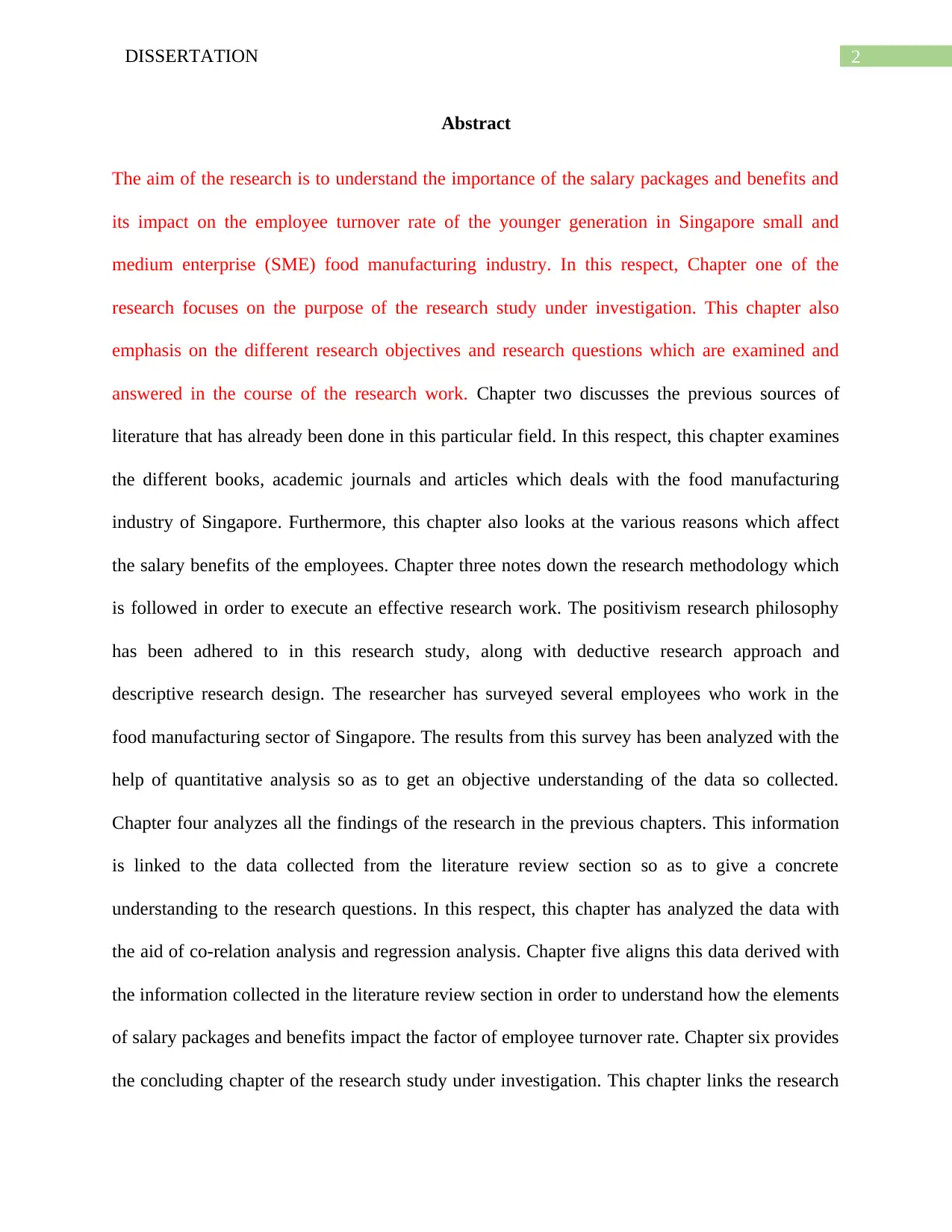
2DISSERTATION
Abstract
The aim of the research is to understand the importance of the salary packages and benefits and
its impact on the employee turnover rate of the younger generation in Singapore small and
medium enterprise (SME) food manufacturing industry. In this respect, Chapter one of the
research focuses on the purpose of the research study under investigation. This chapter also
emphasis on the different research objectives and research questions which are examined and
answered in the course of the research work. Chapter two discusses the previous sources of
literature that has already been done in this particular field. In this respect, this chapter examines
the different books, academic journals and articles which deals with the food manufacturing
industry of Singapore. Furthermore, this chapter also looks at the various reasons which affect
the salary benefits of the employees. Chapter three notes down the research methodology which
is followed in order to execute an effective research work. The positivism research philosophy
has been adhered to in this research study, along with deductive research approach and
descriptive research design. The researcher has surveyed several employees who work in the
food manufacturing sector of Singapore. The results from this survey has been analyzed with the
help of quantitative analysis so as to get an objective understanding of the data so collected.
Chapter four analyzes all the findings of the research in the previous chapters. This information
is linked to the data collected from the literature review section so as to give a concrete
understanding to the research questions. In this respect, this chapter has analyzed the data with
the aid of co-relation analysis and regression analysis. Chapter five aligns this data derived with
the information collected in the literature review section in order to understand how the elements
of salary packages and benefits impact the factor of employee turnover rate. Chapter six provides
the concluding chapter of the research study under investigation. This chapter links the research
Abstract
The aim of the research is to understand the importance of the salary packages and benefits and
its impact on the employee turnover rate of the younger generation in Singapore small and
medium enterprise (SME) food manufacturing industry. In this respect, Chapter one of the
research focuses on the purpose of the research study under investigation. This chapter also
emphasis on the different research objectives and research questions which are examined and
answered in the course of the research work. Chapter two discusses the previous sources of
literature that has already been done in this particular field. In this respect, this chapter examines
the different books, academic journals and articles which deals with the food manufacturing
industry of Singapore. Furthermore, this chapter also looks at the various reasons which affect
the salary benefits of the employees. Chapter three notes down the research methodology which
is followed in order to execute an effective research work. The positivism research philosophy
has been adhered to in this research study, along with deductive research approach and
descriptive research design. The researcher has surveyed several employees who work in the
food manufacturing sector of Singapore. The results from this survey has been analyzed with the
help of quantitative analysis so as to get an objective understanding of the data so collected.
Chapter four analyzes all the findings of the research in the previous chapters. This information
is linked to the data collected from the literature review section so as to give a concrete
understanding to the research questions. In this respect, this chapter has analyzed the data with
the aid of co-relation analysis and regression analysis. Chapter five aligns this data derived with
the information collected in the literature review section in order to understand how the elements
of salary packages and benefits impact the factor of employee turnover rate. Chapter six provides
the concluding chapter of the research study under investigation. This chapter links the research
⊘ This is a preview!⊘
Do you want full access?
Subscribe today to unlock all pages.

Trusted by 1+ million students worldwide
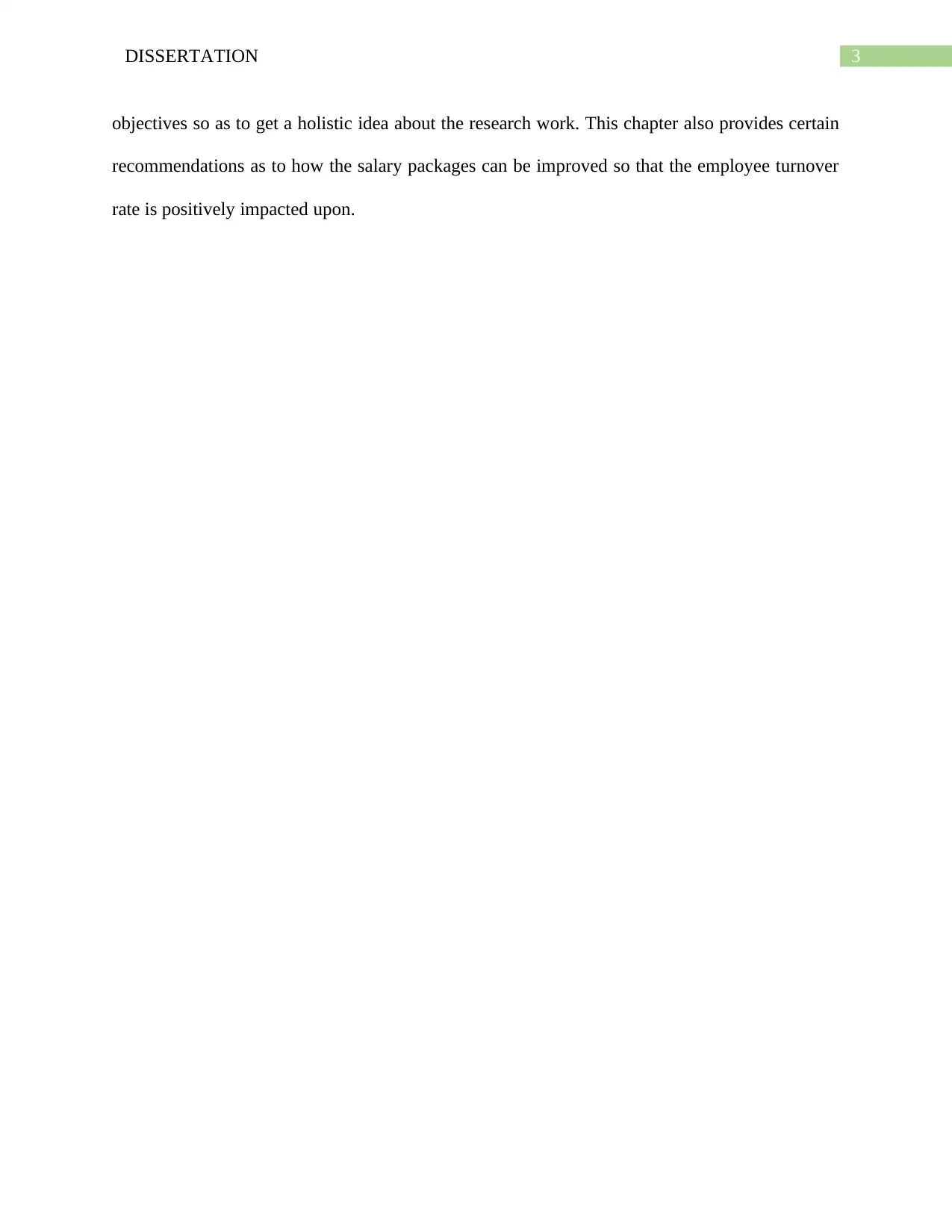
3DISSERTATION
objectives so as to get a holistic idea about the research work. This chapter also provides certain
recommendations as to how the salary packages can be improved so that the employee turnover
rate is positively impacted upon.
objectives so as to get a holistic idea about the research work. This chapter also provides certain
recommendations as to how the salary packages can be improved so that the employee turnover
rate is positively impacted upon.
Paraphrase This Document
Need a fresh take? Get an instant paraphrase of this document with our AI Paraphraser

4DISSERTATION
Table of Contents
Chapter 1: Introduction..................................................................................................................10
1.0 Overview..............................................................................................................................10
1.1 Problem Statement...............................................................................................................11
1.2 Research Aim.......................................................................................................................12
1.3 Research Objectives.............................................................................................................12
1.4 Research Questions..............................................................................................................12
1.5 Research Rationale..............................................................................................................13
1.7 Summary..............................................................................................................................13
Chapter 2: Literature Review.........................................................................................................15
2.0 Overview..............................................................................................................................15
2.1 Conceptual Framework........................................................................................................15
2.2 Meaning of salary packages.................................................................................................16
2.4 Meaning of Benefits............................................................................................................17
2.3 Meaning of employee turnover rate.....................................................................................17
2.4 Factors affecting the salary packages of the employees......................................................18
2.5 Factors affecting the benefits that are given to the employees............................................25
2.6 Factors influencing the employee turnover rate..................................................................27
2.7 Salary packages and benefits impacting the employee turnover rate..................................29
2.8 Singapore SME food manufacturing industries...................................................................30
Table of Contents
Chapter 1: Introduction..................................................................................................................10
1.0 Overview..............................................................................................................................10
1.1 Problem Statement...............................................................................................................11
1.2 Research Aim.......................................................................................................................12
1.3 Research Objectives.............................................................................................................12
1.4 Research Questions..............................................................................................................12
1.5 Research Rationale..............................................................................................................13
1.7 Summary..............................................................................................................................13
Chapter 2: Literature Review.........................................................................................................15
2.0 Overview..............................................................................................................................15
2.1 Conceptual Framework........................................................................................................15
2.2 Meaning of salary packages.................................................................................................16
2.4 Meaning of Benefits............................................................................................................17
2.3 Meaning of employee turnover rate.....................................................................................17
2.4 Factors affecting the salary packages of the employees......................................................18
2.5 Factors affecting the benefits that are given to the employees............................................25
2.6 Factors influencing the employee turnover rate..................................................................27
2.7 Salary packages and benefits impacting the employee turnover rate..................................29
2.8 Singapore SME food manufacturing industries...................................................................30
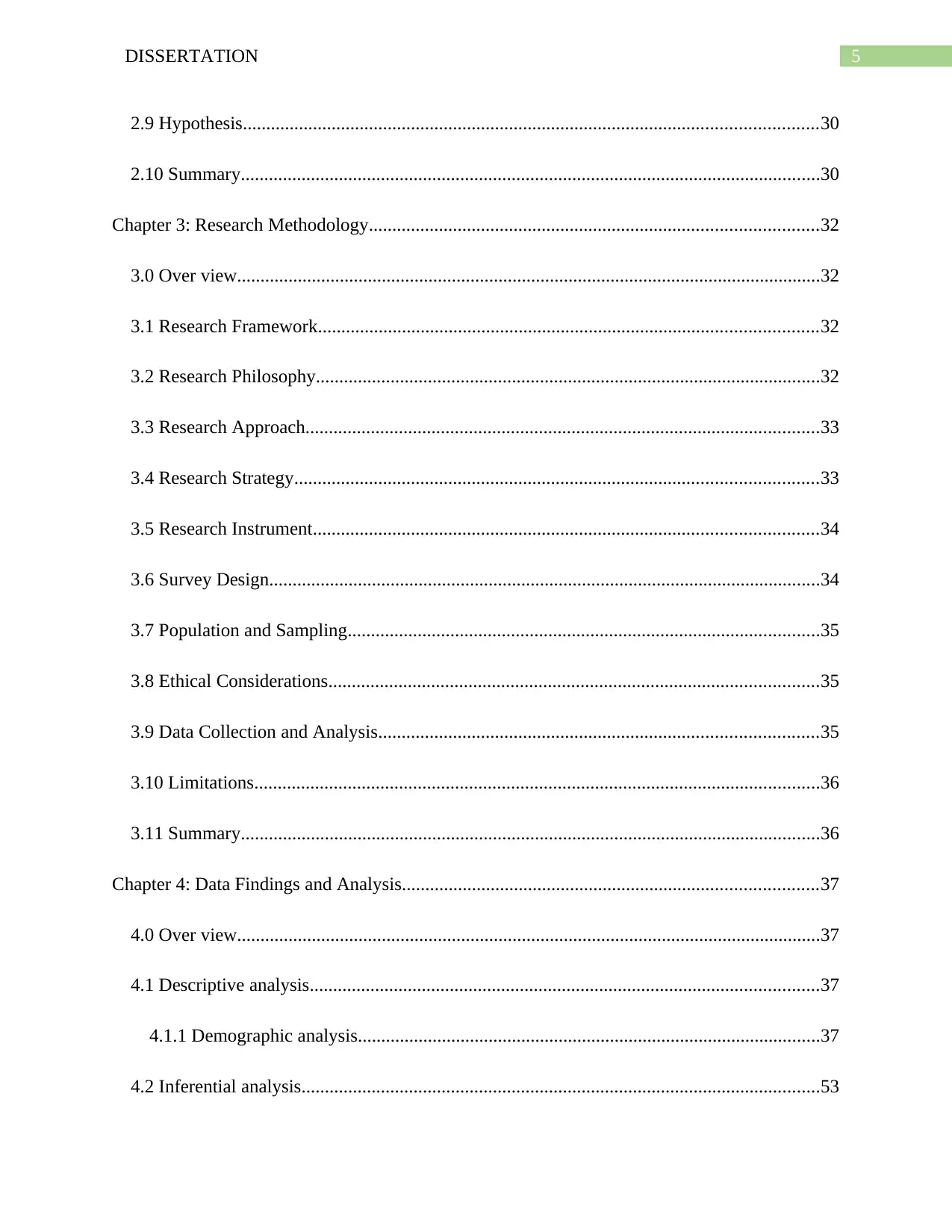
5DISSERTATION
2.9 Hypothesis...........................................................................................................................30
2.10 Summary............................................................................................................................30
Chapter 3: Research Methodology................................................................................................32
3.0 Over view.............................................................................................................................32
3.1 Research Framework...........................................................................................................32
3.2 Research Philosophy............................................................................................................32
3.3 Research Approach..............................................................................................................33
3.4 Research Strategy................................................................................................................33
3.5 Research Instrument............................................................................................................34
3.6 Survey Design......................................................................................................................34
3.7 Population and Sampling.....................................................................................................35
3.8 Ethical Considerations.........................................................................................................35
3.9 Data Collection and Analysis..............................................................................................35
3.10 Limitations.........................................................................................................................36
3.11 Summary............................................................................................................................36
Chapter 4: Data Findings and Analysis.........................................................................................37
4.0 Over view.............................................................................................................................37
4.1 Descriptive analysis.............................................................................................................37
4.1.1 Demographic analysis...................................................................................................37
4.2 Inferential analysis...............................................................................................................53
2.9 Hypothesis...........................................................................................................................30
2.10 Summary............................................................................................................................30
Chapter 3: Research Methodology................................................................................................32
3.0 Over view.............................................................................................................................32
3.1 Research Framework...........................................................................................................32
3.2 Research Philosophy............................................................................................................32
3.3 Research Approach..............................................................................................................33
3.4 Research Strategy................................................................................................................33
3.5 Research Instrument............................................................................................................34
3.6 Survey Design......................................................................................................................34
3.7 Population and Sampling.....................................................................................................35
3.8 Ethical Considerations.........................................................................................................35
3.9 Data Collection and Analysis..............................................................................................35
3.10 Limitations.........................................................................................................................36
3.11 Summary............................................................................................................................36
Chapter 4: Data Findings and Analysis.........................................................................................37
4.0 Over view.............................................................................................................................37
4.1 Descriptive analysis.............................................................................................................37
4.1.1 Demographic analysis...................................................................................................37
4.2 Inferential analysis...............................................................................................................53
⊘ This is a preview!⊘
Do you want full access?
Subscribe today to unlock all pages.

Trusted by 1+ million students worldwide
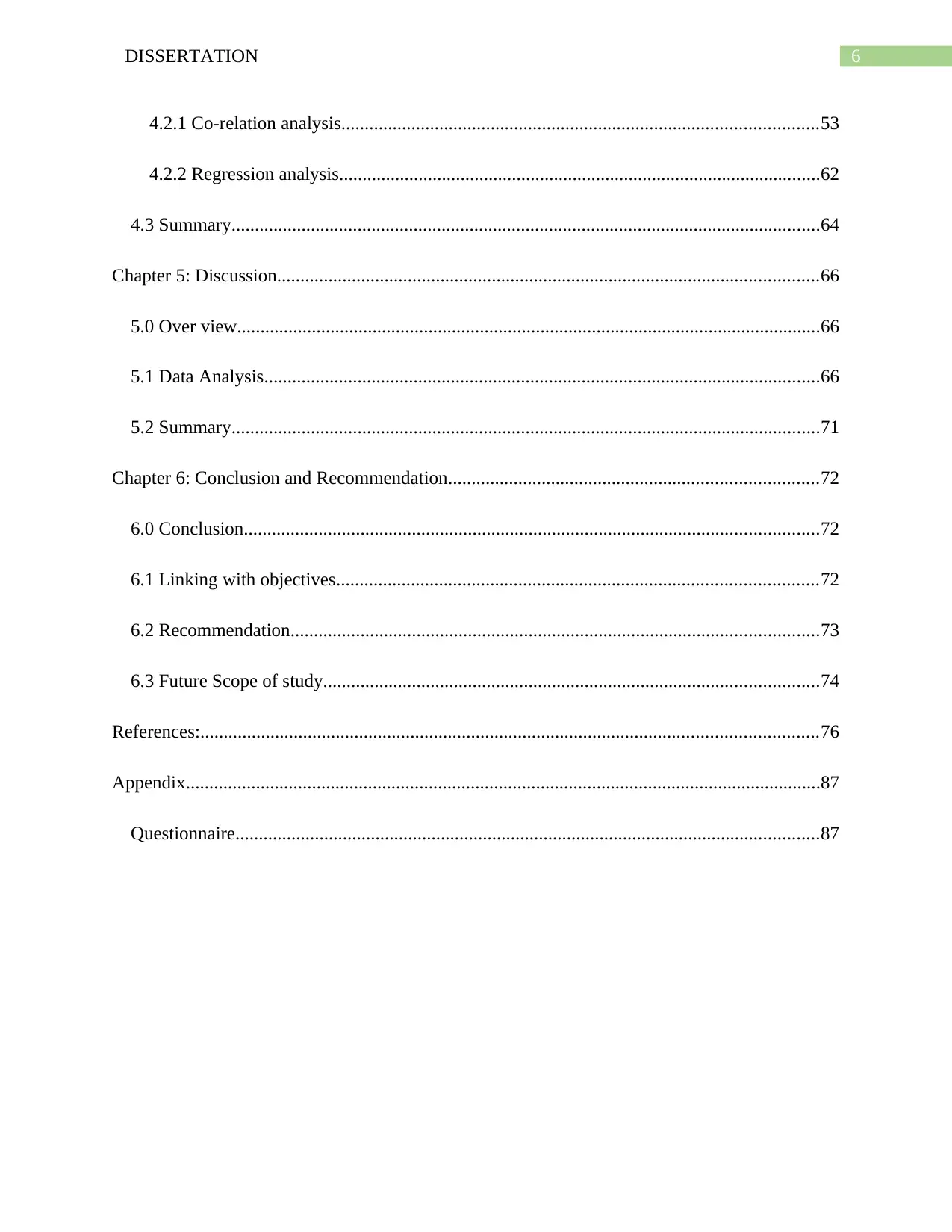
6DISSERTATION
4.2.1 Co-relation analysis......................................................................................................53
4.2.2 Regression analysis.......................................................................................................62
4.3 Summary..............................................................................................................................64
Chapter 5: Discussion....................................................................................................................66
5.0 Over view.............................................................................................................................66
5.1 Data Analysis.......................................................................................................................66
5.2 Summary..............................................................................................................................71
Chapter 6: Conclusion and Recommendation...............................................................................72
6.0 Conclusion...........................................................................................................................72
6.1 Linking with objectives.......................................................................................................72
6.2 Recommendation.................................................................................................................73
6.3 Future Scope of study..........................................................................................................74
References:....................................................................................................................................76
Appendix........................................................................................................................................87
Questionnaire.............................................................................................................................87
4.2.1 Co-relation analysis......................................................................................................53
4.2.2 Regression analysis.......................................................................................................62
4.3 Summary..............................................................................................................................64
Chapter 5: Discussion....................................................................................................................66
5.0 Over view.............................................................................................................................66
5.1 Data Analysis.......................................................................................................................66
5.2 Summary..............................................................................................................................71
Chapter 6: Conclusion and Recommendation...............................................................................72
6.0 Conclusion...........................................................................................................................72
6.1 Linking with objectives.......................................................................................................72
6.2 Recommendation.................................................................................................................73
6.3 Future Scope of study..........................................................................................................74
References:....................................................................................................................................76
Appendix........................................................................................................................................87
Questionnaire.............................................................................................................................87
Paraphrase This Document
Need a fresh take? Get an instant paraphrase of this document with our AI Paraphraser
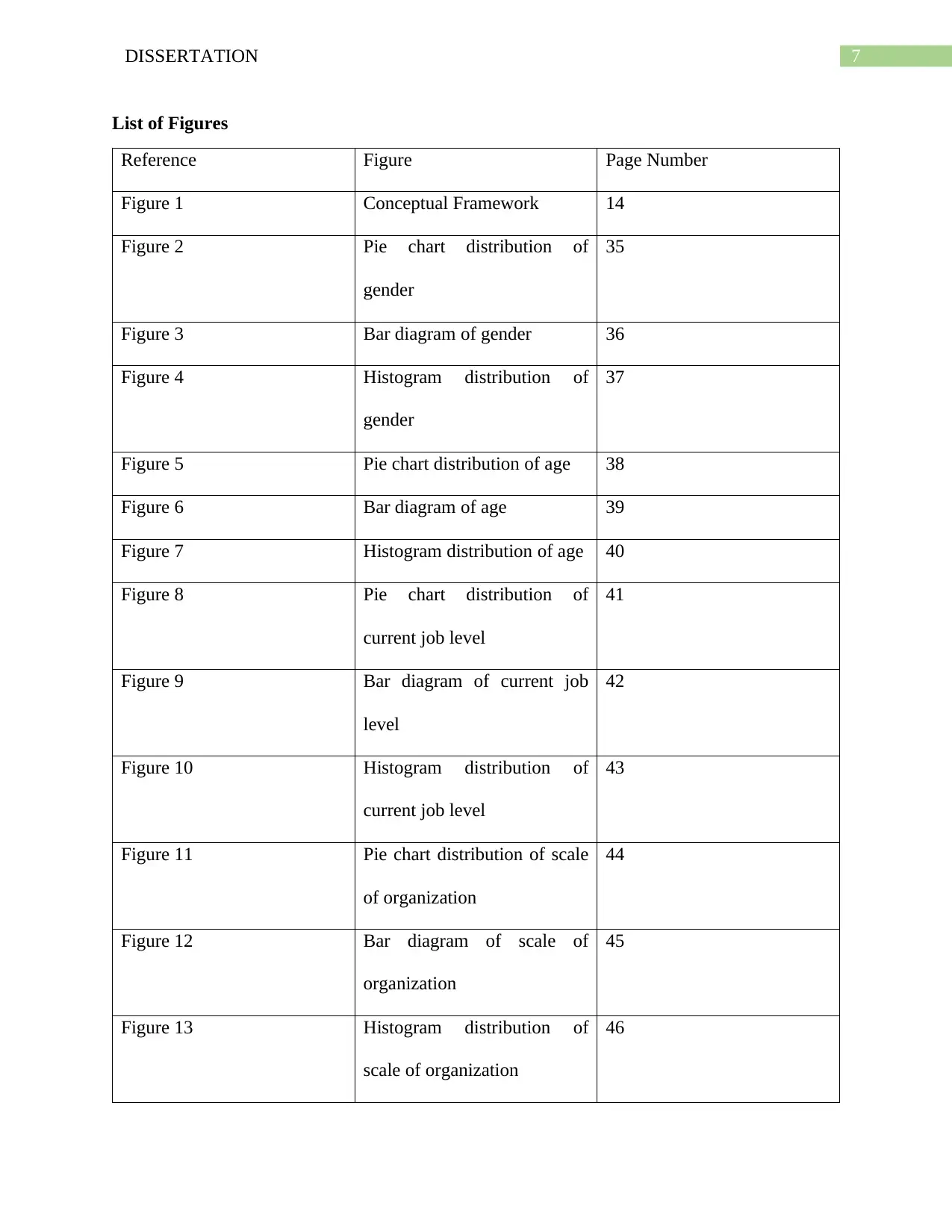
7DISSERTATION
List of Figures
Reference Figure Page Number
Figure 1 Conceptual Framework 14
Figure 2 Pie chart distribution of
gender
35
Figure 3 Bar diagram of gender 36
Figure 4 Histogram distribution of
gender
37
Figure 5 Pie chart distribution of age 38
Figure 6 Bar diagram of age 39
Figure 7 Histogram distribution of age 40
Figure 8 Pie chart distribution of
current job level
41
Figure 9 Bar diagram of current job
level
42
Figure 10 Histogram distribution of
current job level
43
Figure 11 Pie chart distribution of scale
of organization
44
Figure 12 Bar diagram of scale of
organization
45
Figure 13 Histogram distribution of
scale of organization
46
List of Figures
Reference Figure Page Number
Figure 1 Conceptual Framework 14
Figure 2 Pie chart distribution of
gender
35
Figure 3 Bar diagram of gender 36
Figure 4 Histogram distribution of
gender
37
Figure 5 Pie chart distribution of age 38
Figure 6 Bar diagram of age 39
Figure 7 Histogram distribution of age 40
Figure 8 Pie chart distribution of
current job level
41
Figure 9 Bar diagram of current job
level
42
Figure 10 Histogram distribution of
current job level
43
Figure 11 Pie chart distribution of scale
of organization
44
Figure 12 Bar diagram of scale of
organization
45
Figure 13 Histogram distribution of
scale of organization
46
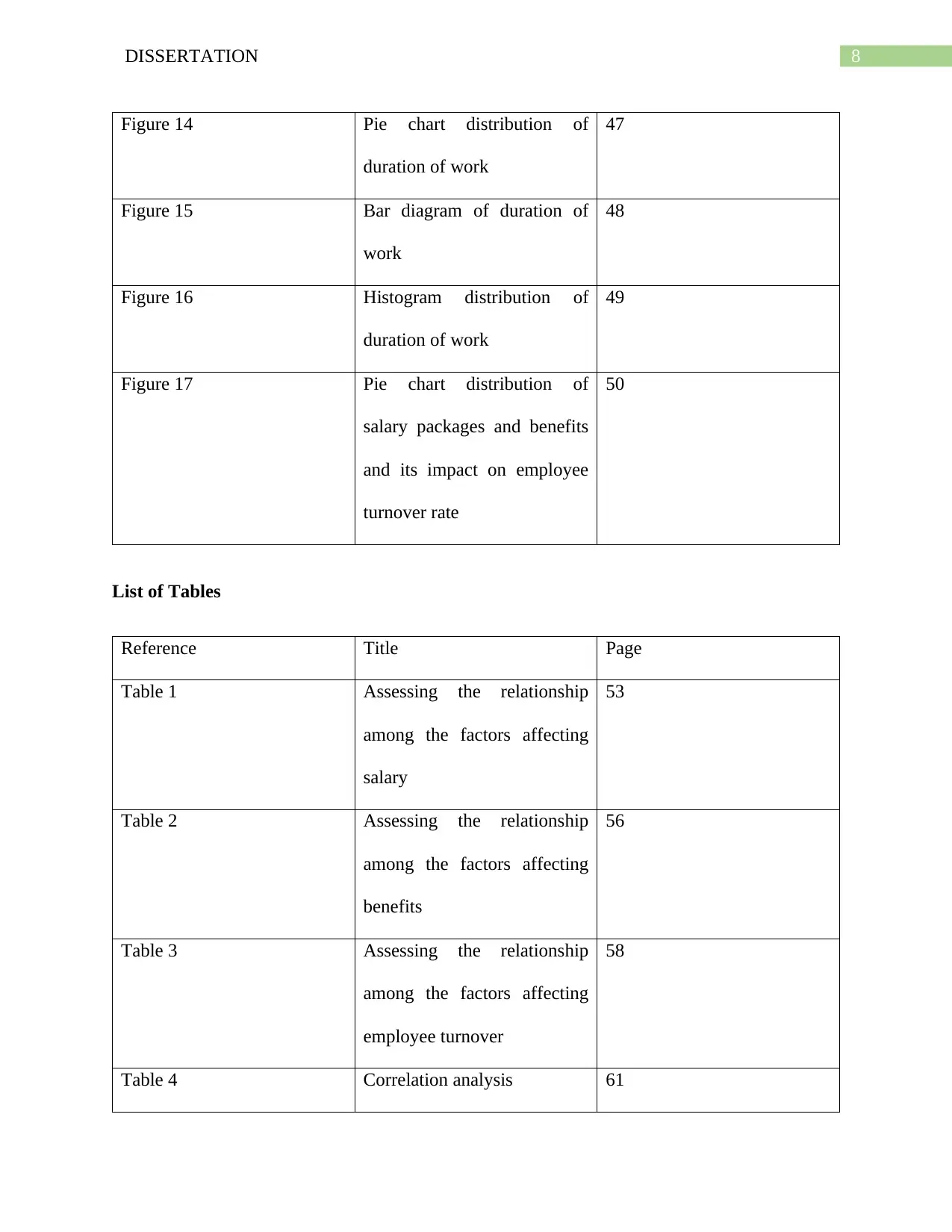
8DISSERTATION
Figure 14 Pie chart distribution of
duration of work
47
Figure 15 Bar diagram of duration of
work
48
Figure 16 Histogram distribution of
duration of work
49
Figure 17 Pie chart distribution of
salary packages and benefits
and its impact on employee
turnover rate
50
List of Tables
Reference Title Page
Table 1 Assessing the relationship
among the factors affecting
salary
53
Table 2 Assessing the relationship
among the factors affecting
benefits
56
Table 3 Assessing the relationship
among the factors affecting
employee turnover
58
Table 4 Correlation analysis 61
Figure 14 Pie chart distribution of
duration of work
47
Figure 15 Bar diagram of duration of
work
48
Figure 16 Histogram distribution of
duration of work
49
Figure 17 Pie chart distribution of
salary packages and benefits
and its impact on employee
turnover rate
50
List of Tables
Reference Title Page
Table 1 Assessing the relationship
among the factors affecting
salary
53
Table 2 Assessing the relationship
among the factors affecting
benefits
56
Table 3 Assessing the relationship
among the factors affecting
employee turnover
58
Table 4 Correlation analysis 61
⊘ This is a preview!⊘
Do you want full access?
Subscribe today to unlock all pages.

Trusted by 1+ million students worldwide

9DISSERTATION
Table 5 Regression analysis of salary
packages and employee
turnover
63
Table 6 Regression analysis of
benefits and employee
turnover
64
Table 5 Regression analysis of salary
packages and employee
turnover
63
Table 6 Regression analysis of
benefits and employee
turnover
64
Paraphrase This Document
Need a fresh take? Get an instant paraphrase of this document with our AI Paraphraser

10DISSERTATION
Chapter 1: Introduction
1.0 Overview
The contemporary world of today has seen a surge in the number of industries. The
process of industrialization had been introduced in order to ease the lives of the human beings in
the society (Schuck and Rabe-Hemp 2018). A considerable change in the functioning of the
industries which can be noticed in the modern time period is that the market structure is
organized on the basis of capitalist economy. This means that the industries are required to focus
on the aspects of competition and merit. The primary objective of every business organization is
to increase its level of profit margin (Lee and Sabharwal 2016). In this respect, the different
business firms are motivated to increase its level of production. Most of the level of production
depends on the work efficiency of the employees. This observation points to the importance of
the employees in the position of the business firms. There is a need on the part of the
management of every business organization to ensure that the concerned employees are
sufficiently compensated in the form of better salary packages (Chi, Yeh and Guo 2018). The
rise in the salaries of the employees leads to a consequent rise in the turnover rate of the
employees.
Every employee work in a business organization with the aim of earning some
compensation for the hard work done by him or her in the firm. This compensation is primarily
given in the form of salary and wages (Meng, Lu and Shen 2018). However, simply providing a
basic salary and wage is not enough. After working for a considerable period of time, every
employee is of the idea that their salary would increase at a significant pace. In this regard, salary
benefits are quite essential to keep the employees motivated to work in an efficient manner. On
the other hand, the employee turnover rate refers to the condition where there is presence of a
Chapter 1: Introduction
1.0 Overview
The contemporary world of today has seen a surge in the number of industries. The
process of industrialization had been introduced in order to ease the lives of the human beings in
the society (Schuck and Rabe-Hemp 2018). A considerable change in the functioning of the
industries which can be noticed in the modern time period is that the market structure is
organized on the basis of capitalist economy. This means that the industries are required to focus
on the aspects of competition and merit. The primary objective of every business organization is
to increase its level of profit margin (Lee and Sabharwal 2016). In this respect, the different
business firms are motivated to increase its level of production. Most of the level of production
depends on the work efficiency of the employees. This observation points to the importance of
the employees in the position of the business firms. There is a need on the part of the
management of every business organization to ensure that the concerned employees are
sufficiently compensated in the form of better salary packages (Chi, Yeh and Guo 2018). The
rise in the salaries of the employees leads to a consequent rise in the turnover rate of the
employees.
Every employee work in a business organization with the aim of earning some
compensation for the hard work done by him or her in the firm. This compensation is primarily
given in the form of salary and wages (Meng, Lu and Shen 2018). However, simply providing a
basic salary and wage is not enough. After working for a considerable period of time, every
employee is of the idea that their salary would increase at a significant pace. In this regard, salary
benefits are quite essential to keep the employees motivated to work in an efficient manner. On
the other hand, the employee turnover rate refers to the condition where there is presence of a
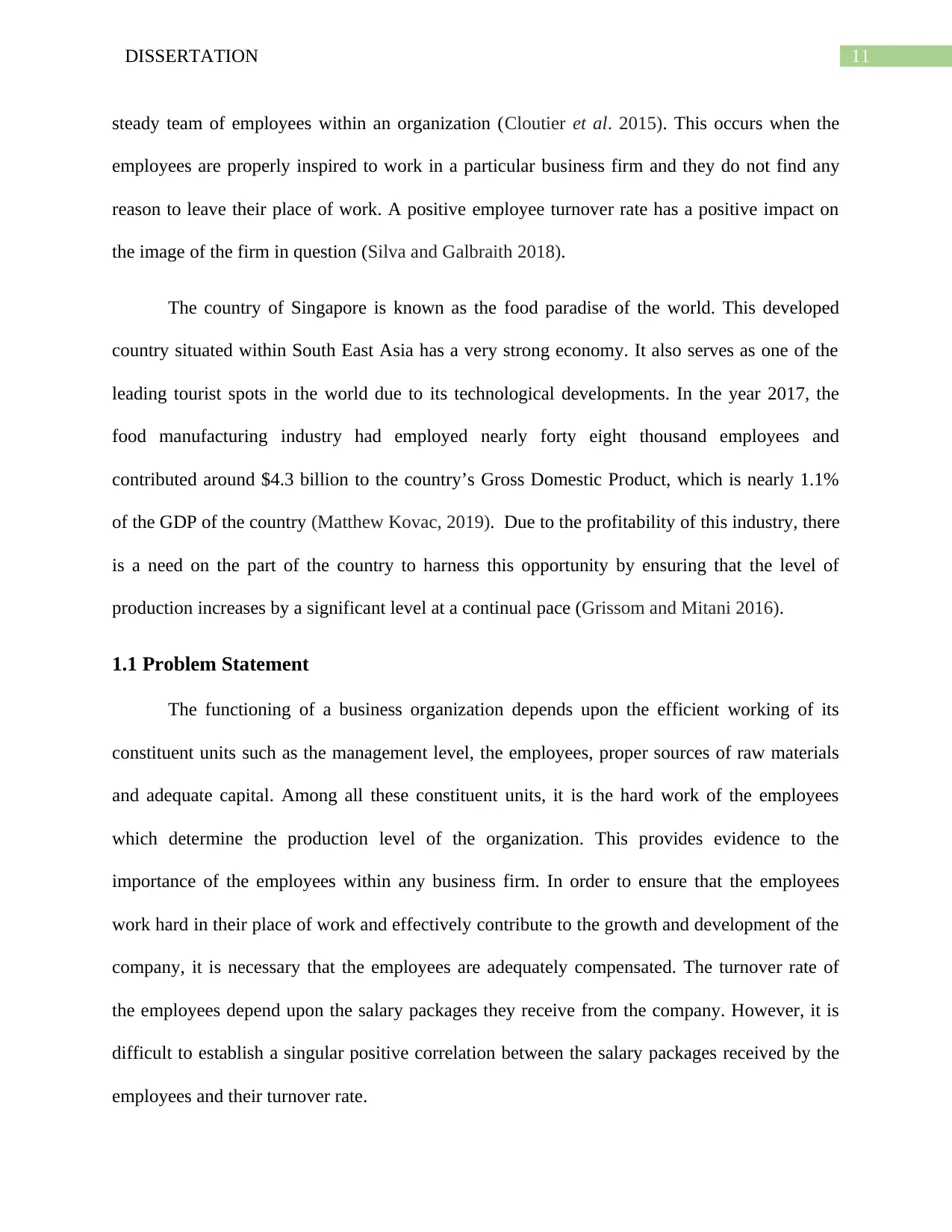
11DISSERTATION
steady team of employees within an organization (Cloutier et al. 2015). This occurs when the
employees are properly inspired to work in a particular business firm and they do not find any
reason to leave their place of work. A positive employee turnover rate has a positive impact on
the image of the firm in question (Silva and Galbraith 2018).
The country of Singapore is known as the food paradise of the world. This developed
country situated within South East Asia has a very strong economy. It also serves as one of the
leading tourist spots in the world due to its technological developments. In the year 2017, the
food manufacturing industry had employed nearly forty eight thousand employees and
contributed around $4.3 billion to the country’s Gross Domestic Product, which is nearly 1.1%
of the GDP of the country (Matthew Kovac, 2019). Due to the profitability of this industry, there
is a need on the part of the country to harness this opportunity by ensuring that the level of
production increases by a significant level at a continual pace (Grissom and Mitani 2016).
1.1 Problem Statement
The functioning of a business organization depends upon the efficient working of its
constituent units such as the management level, the employees, proper sources of raw materials
and adequate capital. Among all these constituent units, it is the hard work of the employees
which determine the production level of the organization. This provides evidence to the
importance of the employees within any business firm. In order to ensure that the employees
work hard in their place of work and effectively contribute to the growth and development of the
company, it is necessary that the employees are adequately compensated. The turnover rate of
the employees depend upon the salary packages they receive from the company. However, it is
difficult to establish a singular positive correlation between the salary packages received by the
employees and their turnover rate.
steady team of employees within an organization (Cloutier et al. 2015). This occurs when the
employees are properly inspired to work in a particular business firm and they do not find any
reason to leave their place of work. A positive employee turnover rate has a positive impact on
the image of the firm in question (Silva and Galbraith 2018).
The country of Singapore is known as the food paradise of the world. This developed
country situated within South East Asia has a very strong economy. It also serves as one of the
leading tourist spots in the world due to its technological developments. In the year 2017, the
food manufacturing industry had employed nearly forty eight thousand employees and
contributed around $4.3 billion to the country’s Gross Domestic Product, which is nearly 1.1%
of the GDP of the country (Matthew Kovac, 2019). Due to the profitability of this industry, there
is a need on the part of the country to harness this opportunity by ensuring that the level of
production increases by a significant level at a continual pace (Grissom and Mitani 2016).
1.1 Problem Statement
The functioning of a business organization depends upon the efficient working of its
constituent units such as the management level, the employees, proper sources of raw materials
and adequate capital. Among all these constituent units, it is the hard work of the employees
which determine the production level of the organization. This provides evidence to the
importance of the employees within any business firm. In order to ensure that the employees
work hard in their place of work and effectively contribute to the growth and development of the
company, it is necessary that the employees are adequately compensated. The turnover rate of
the employees depend upon the salary packages they receive from the company. However, it is
difficult to establish a singular positive correlation between the salary packages received by the
employees and their turnover rate.
⊘ This is a preview!⊘
Do you want full access?
Subscribe today to unlock all pages.

Trusted by 1+ million students worldwide
1 out of 90
Related Documents
Your All-in-One AI-Powered Toolkit for Academic Success.
+13062052269
info@desklib.com
Available 24*7 on WhatsApp / Email
![[object Object]](/_next/static/media/star-bottom.7253800d.svg)
Unlock your academic potential
Copyright © 2020–2025 A2Z Services. All Rights Reserved. Developed and managed by ZUCOL.





